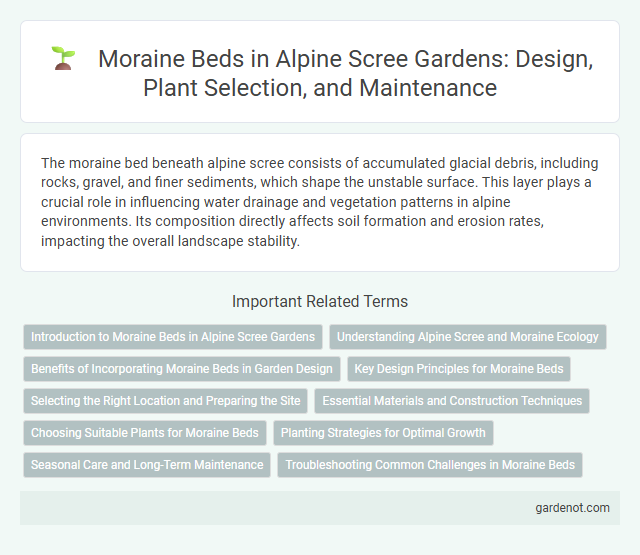The moraine bed beneath alpine scree consists of accumulated glacial debris, including rocks, gravel, and finer sediments, which shape the unstable surface. This layer plays a crucial role in influencing water drainage and vegetation patterns in alpine environments. Its composition directly affects soil formation and erosion rates, impacting the overall landscape stability.
Introduction to Moraine Beds in Alpine Scree Gardens
Moraine beds in alpine scree gardens consist of accumulated glacial debris, including rocks, gravel, and sediment, deposited by retreating glaciers. These beds provide a unique substrate that influences soil composition, drainage, and plant colonization, creating dynamic microhabitats for specialized alpine flora. Their formation and composition play a critical role in shaping the ecological structure and biodiversity of alpine scree environments.
Understanding Alpine Scree and Moraine Ecology
Moraine beds in alpine scree environments serve as critical habitats supporting diverse plant and microbial communities adapted to cold, unstable substrates. These rocky formations, composed of glacial debris, influence soil development and water retention, shaping unique ecological niches. Understanding the interplay between scree dynamics and moraine ecology enhances conservation strategies for fragile alpine ecosystems.
Benefits of Incorporating Moraine Beds in Garden Design
Moraine beds enhance garden design by promoting excellent drainage and soil aeration, essential for the healthy growth of alpine scree plants. The mixture of small rocks and mineral-rich soil in moraine beds provides a natural, nutrient-dense environment that supports native alpine flora. Incorporating moraine beds mimics natural alpine habitats, increasing biodiversity and creating visually striking, low-maintenance garden landscapes.
Key Design Principles for Moraine Beds
Moraine beds in alpine scree environments require optimal drainage and stability to prevent erosion and sediment displacement. The design principles emphasize layering coarse, permeable materials such as gravel and cobbles to facilitate water flow while providing structural support against freeze-thaw cycles. Incorporating vegetation with deep-rooted alpine plants enhances soil cohesion, reducing the risk of slope failure and maintaining ecological balance.
Selecting the Right Location and Preparing the Site
Choosing the right location for a moraine bed in alpine scree requires careful assessment of slope stability, drainage patterns, and solar exposure to ensure structural integrity and optimal plant growth. Preparing the site involves clearing loose debris, grading the area to prevent water accumulation, and incorporating native soil to enhance moisture retention and nutrient availability. Proper site selection and preparation maximize the moraine bed's ecological resilience and aesthetic integration within the alpine scree environment.
Essential Materials and Construction Techniques
Moraine beds in alpine scree environments consist primarily of unsorted glacial debris, including a mix of clay, silt, sand, gravel, and boulders, providing essential materials for foundational stability. Construction techniques emphasize careful layering and compaction to maximize drainage and prevent erosion, often utilizing geotextiles to reinforce the structure. Understanding the granulometry and permeability of moraine soils is critical for effective slope stabilization and sustainable infrastructure development in mountainous terrain.
Choosing Suitable Plants for Moraine Beds
Selecting suitable plants for moraine beds involves prioritizing species adapted to rocky, nutrient-poor alpine scree conditions such as Dryas octopetala and Saxifraga oppositifolia. These plants exhibit drought tolerance and strong root systems that stabilize loose substrates, preventing erosion on unstable moraine surfaces. Incorporating native alpine flora enhances biodiversity and supports the ecological balance within moraine bed habitats.
Planting Strategies for Optimal Growth
Moraine beds in alpine scree provide a challenging substrate with unstable, rocky soil and limited nutrients, requiring specialized planting strategies for optimal growth. Selecting native pioneer species with deep root systems and drought tolerance enhances soil stabilization and nutrient retention. Incorporating organic amendments and using protective mulches improve moisture retention and create microhabitats conducive to plant establishment and long-term growth in morainic environments.
Seasonal Care and Long-Term Maintenance
Moraine beds in Alpine scree require careful seasonal management to prevent erosion and support vegetation regrowth, involving regular debris removal and moisture regulation during snowmelt periods. Long-term maintenance emphasizes stabilizing sediment layers and promoting native plant colonization to enhance slope durability. Monitoring soil composition and adjusting drainage systems ensure sustained ecological balance and reduce the risk of landslides.
Troubleshooting Common Challenges in Moraine Beds
Moraine beds often present challenges such as poor drainage and unstable sediment layers, which can hinder vegetation growth and increase erosion risk. Solutions include improving soil aeration through mechanical loosening and implementing effective water management systems to regulate moisture levels. Monitoring sediment movement and stabilizing slopes with native alpine plants can mitigate further degradation and promote ecological balance.
Moraine bed Infographic

 gardenot.com
gardenot.com